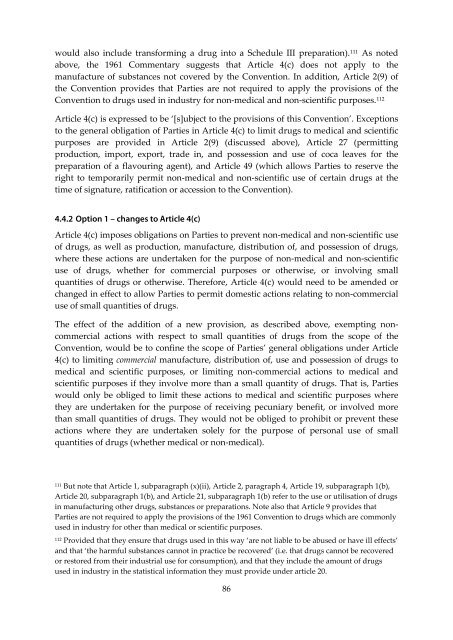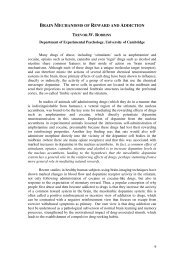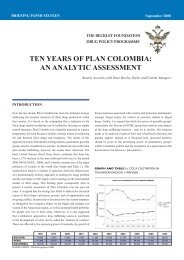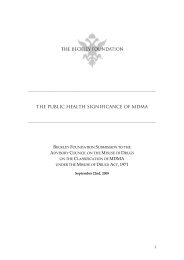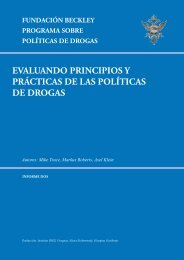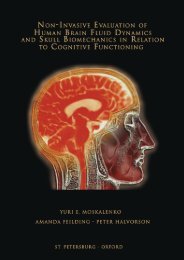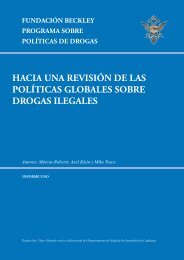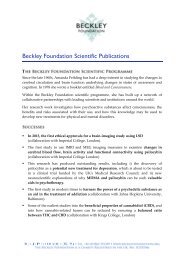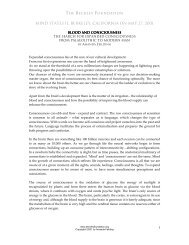‘Production’ of <strong>drug</strong>s is defined in Article 1(1)(t) as ‘<strong>the</strong> separation of opium, cocaleaves, cannabis and cannabis resin from <strong>the</strong> plants from which <strong>the</strong>y are obtained’. It isintended <strong>to</strong> capture agricultural operations ra<strong>the</strong>r than industrial processes involved inmanufacturing <strong>drug</strong>s. 106 ‘Manufacture’ is defined in Article 1(1)(n) as ‘all processes,o<strong>the</strong>r than production, by which <strong>drug</strong>s may be obtained [including] refining as well as<strong>the</strong> transformation of o<strong>the</strong>r <strong>drug</strong>s’. The 1961 Commentary suggests that <strong>the</strong> limitation ofmanufacture <strong>to</strong> medical and scientific purposes in Article 4(c) relates only <strong>to</strong>manufacture of <strong>drug</strong>s (defined in Article 1(1)(j) as any substance in Schedule 1 and II of<strong>the</strong> Convention), and not <strong>to</strong> <strong>the</strong> manufacture from <strong>drug</strong>s of substances not covered by<strong>the</strong> Convention. 107‘Import’ and ‘export’ are defined in Article 1(1)(m) as ‘in <strong>the</strong>ir respective connotations,<strong>the</strong> physical transfer of <strong>drug</strong>s from one State <strong>to</strong> ano<strong>the</strong>r State, or from one terri<strong>to</strong>ry <strong>to</strong>ano<strong>the</strong>r terri<strong>to</strong>ry of <strong>the</strong> same State’. ‘Distribution’ is not defined in <strong>the</strong> Convention. Itsordinary meaning is ‘<strong>the</strong> act of sharing something out among a number of recipients’. 108The UN Commentary on <strong>the</strong> 1988 Convention 109 (‘1988 Commentary’) notes thisordinary meaning but suggests that a more apt interpretation of distribution (as used in<strong>the</strong> provisions of <strong>the</strong> 1988 Convention dealing with criminalisation of participation incontext of illicit traffic in <strong>drug</strong>s) may be by reference <strong>to</strong> ‘distribu<strong>to</strong>rship’ – <strong>the</strong>commercial role of ensuring that goods pass from manufacturer or importer <strong>to</strong>wholesaler or retailers, or in o<strong>the</strong>r words, <strong>the</strong> movement of goods through <strong>the</strong> supplychain. 110According <strong>to</strong> <strong>the</strong> 1961 Commentary, it is clear that ‘possession’ in Article 4(c) includespossession for <strong>the</strong> purpose of personal use of <strong>drug</strong>s, as well as possession forcommercial distribution, and <strong>the</strong>refore that Parties are generally obliged <strong>un</strong>der Article4(c) <strong>to</strong> limit both kinds of possession <strong>to</strong> medical and scientific purposes (although it isnot clear whe<strong>the</strong>r possession for non-medical and non-scientific personal use must bemade a p<strong>un</strong>ishable offence <strong>un</strong>der <strong>the</strong> penal provisions of Article 36, as discussed inrelation <strong>to</strong> Article 36 below).‘Use’ is not defined in <strong>the</strong> Convention, but its meaning in Article 4(c) would clearlyinclude consumption of <strong>drug</strong>s by individuals. It is <strong>un</strong>clear whe<strong>the</strong>r it would also extend<strong>to</strong> use of <strong>drug</strong>s <strong>to</strong> manufacture o<strong>the</strong>r <strong>drug</strong>s, substances or preparations, but it seemsmost likely that all <strong>the</strong> forms of conduct intended <strong>to</strong> be captured in this regard arecovered <strong>un</strong>der ‘manufacture’ in Article 4(c) – defined in Article 1(n) <strong>to</strong> includetransforming a <strong>drug</strong> in<strong>to</strong> ano<strong>the</strong>r <strong>drug</strong> (which by virtue of Article 2, paragraphs 3 and 4,106Boister N. Penal Aspects of <strong>the</strong> UN Drug Conventions. The Hague/London/Bos<strong>to</strong>n: Kluwer LawInternational, 2001, p. 79.1071961 Commentary, p. 16.108Oxford Dictionary of English, Second Edition, revised. Oxford: Oxford University Press, 2009.109United Nations. Commentary on <strong>the</strong> United Nations Convention Against Illicit Traffic in NarcoticDrugs and Psychotropic Substances, 1988. New York: United Nations, 1988 (‘1988 Commentary’).1101988 Commentary, p. 55.85
would also include transforming a <strong>drug</strong> in<strong>to</strong> a Schedule III preparation). 111 As notedabove, <strong>the</strong> 1961 Commentary suggests that Article 4(c) does not apply <strong>to</strong> <strong>the</strong>manufacture of substances not covered by <strong>the</strong> Convention. In addition, Article 2(9) of<strong>the</strong> Convention provides that Parties are not required <strong>to</strong> apply <strong>the</strong> provisions of <strong>the</strong>Convention <strong>to</strong> <strong>drug</strong>s used in industry for non-medical and non-scientific purposes. 112Article 4(c) is expressed <strong>to</strong> be ‘[s]ubject <strong>to</strong> <strong>the</strong> provisions of this Convention’. Exceptions<strong>to</strong> <strong>the</strong> general obligation of Parties in Article 4(c) <strong>to</strong> limit <strong>drug</strong>s <strong>to</strong> medical and scientificpurposes are provided in Article 2(9) (discussed above), Article 27 (permittingproduction, import, export, trade in, and possession and use of coca leaves for <strong>the</strong>preparation of a flavouring agent), and Article 49 (which allows Parties <strong>to</strong> reserve <strong>the</strong>right <strong>to</strong> temporarily permit non-medical and non-scientific use of certain <strong>drug</strong>s at <strong>the</strong>time of signature, ratification or accession <strong>to</strong> <strong>the</strong> Convention).4.4.2 Option 1 – changes <strong>to</strong> Article 4(c)Article 4(c) imposes obligations on Parties <strong>to</strong> prevent non-medical and non-scientific useof <strong>drug</strong>s, as well as production, manufacture, distribution of, and possession of <strong>drug</strong>s,where <strong>the</strong>se actions are <strong>un</strong>dertaken for <strong>the</strong> purpose of non-medical and non-scientificuse of <strong>drug</strong>s, whe<strong>the</strong>r for commercial purposes or o<strong>the</strong>rwise, or involving smallquantities of <strong>drug</strong>s or o<strong>the</strong>rwise. Therefore, Article 4(c) would need <strong>to</strong> be amended orchanged in effect <strong>to</strong> allow Parties <strong>to</strong> permit domestic actions relating <strong>to</strong> non-commercialuse of small quantities of <strong>drug</strong>s.The effect of <strong>the</strong> addition of a new provision, as described above, exempting noncommercialactions with respect <strong>to</strong> small quantities of <strong>drug</strong>s from <strong>the</strong> scope of <strong>the</strong>Convention, would be <strong>to</strong> confine <strong>the</strong> scope of Parties’ general obligations <strong>un</strong>der Article4(c) <strong>to</strong> limiting commercial manufacture, distribution of, use and possession of <strong>drug</strong>s <strong>to</strong>medical and scientific purposes, or limiting non-commercial actions <strong>to</strong> medical andscientific purposes if <strong>the</strong>y involve more than a small quantity of <strong>drug</strong>s. That is, Partieswould only be obliged <strong>to</strong> limit <strong>the</strong>se actions <strong>to</strong> medical and scientific purposes where<strong>the</strong>y are <strong>un</strong>dertaken for <strong>the</strong> purpose of receiving pec<strong>un</strong>iary benefit, or involved morethan small quantities of <strong>drug</strong>s. They would not be obliged <strong>to</strong> prohibit or prevent <strong>the</strong>seactions where <strong>the</strong>y are <strong>un</strong>dertaken solely for <strong>the</strong> purpose of personal use of smallquantities of <strong>drug</strong>s (whe<strong>the</strong>r medical or non-medical).111But note that Article 1, subparagraph (x)(ii), Article 2, paragraph 4, Article 19, subparagraph 1(b),Article 20, subparagraph 1(b), and Article 21, subparagraph 1(b) refer <strong>to</strong> <strong>the</strong> use or utilisation of <strong>drug</strong>sin manufacturing o<strong>the</strong>r <strong>drug</strong>s, substances or preparations. Note also that Article 9 provides thatParties are not required <strong>to</strong> apply <strong>the</strong> provisions of <strong>the</strong> 1961 Convention <strong>to</strong> <strong>drug</strong>s which are commonlyused in industry for o<strong>the</strong>r than medical or scientific purposes.112Provided that <strong>the</strong>y ensure that <strong>drug</strong>s used in this way ‘are not liable <strong>to</strong> be abused or have ill effects’and that ‘<strong>the</strong> harmful substances cannot in practice be recovered’ (i.e. that <strong>drug</strong>s cannot be recoveredor res<strong>to</strong>red from <strong>the</strong>ir industrial use for consumption), and that <strong>the</strong>y include <strong>the</strong> amo<strong>un</strong>t of <strong>drug</strong>sused in industry in <strong>the</strong> statistical information <strong>the</strong>y must provide <strong>un</strong>der article 20.86
- Page 2 and 3:
ROADMAPS TO REFORMINGTHE UN DRUG CO
- Page 4 and 5:
ContentsPreface ...................
- Page 6 and 7:
PrefaceTHE IDEA FOR this Report cam
- Page 8:
PART I. POSSIBLE ROADMAPS
- Page 11 and 12:
hope for serious progress, but we c
- Page 13 and 14:
We do not underestimate the difficu
- Page 15 and 16:
also imposes requirements concernin
- Page 17 and 18:
domestic market, just as producers
- Page 19 and 20:
Protocol strengthened some provisio
- Page 21 and 22:
ut considerably less potency than s
- Page 23 and 24:
has announced its intention to reac
- Page 25 and 26:
objected to. Concerning the 1971 tr
- Page 27 and 28:
Table 2. Summary of reservations to
- Page 29 and 30:
Reservations about traditional use
- Page 31 and 32:
As Swaine notes, ‘the Vienna Conv
- Page 33 and 34:
unhappy about a country implementin
- Page 35 and 36:
Preemption by a new ‘single conve
- Page 37 and 38:
and their effort was rejected by a
- Page 39 and 40:
national or subnational level. Proh
- Page 42 and 43:
Chapter 5. Proposed treaty amendmen
- Page 44 and 45: Article 1. DefinitionsExcept where
- Page 46 and 47: Article 36 - penal provisionsIn Art
- Page 48 and 49: Article 7. Special Provisions regar
- Page 50 and 51: and to ensure adequate supplies of
- Page 52 and 53: Article 1 − definition of ‘cons
- Page 54 and 55: Article 19 - estimates of drug requ
- Page 56 and 57: Article 21. Limitation of Manufactu
- Page 58 and 59: contrary to a law or regulation ado
- Page 60 and 61: 1. in subparagraph (a):a) after ‘
- Page 62 and 63: ) for ‘in accordance with paragra
- Page 64 and 65: include a number of general stateme
- Page 66 and 67: the legality of drug possession. A
- Page 68 and 69: Chapter 7. Conforming the 1961 Conv
- Page 70 and 71: solely by Article 30, which require
- Page 72 and 73: on trade activities referred to in
- Page 74 and 75: (c) Require that licensed manufactu
- Page 76 and 77: issued in the form of counterfoil b
- Page 78: APPENDIXDETAILED COMMENTARY ON AMEN
- Page 81 and 82: Articles 21-34 of the Convention im
- Page 83 and 84: dispatch, transport, supply, purcha
- Page 85 and 86: actions involving commercial quanti
- Page 87 and 88: In the 1971 Convention the followin
- Page 89 and 90: 4.1.3 Option 2 - changes to Preambl
- Page 91 and 92: separate estimates and statistical
- Page 93: After ‘scientific research’, in
- Page 97 and 98: (c) subject to the provisions of th
- Page 99 and 100: endangered’ by a Party’s failur
- Page 101 and 102: Article 9. Composition and Function
- Page 103 and 104: 2. The Board shall, in respect of c
- Page 105 and 106: for the right of the INCB to establ
- Page 107 and 108: ) Subject to the deductions referre
- Page 109 and 110: excess quantity must be deducted fr
- Page 111 and 112: prohibition in Article 31(1)(b) aga
- Page 113 and 114: 4.8 Article 20 - statistical return
- Page 115 and 116: separate returns would be required
- Page 117 and 118: 4.9.1 General comments on Article 2
- Page 119 and 120: distributors), and any quantity tak
- Page 121 and 122: a) The quantity consumed, within th
- Page 123 and 124: Article 21 bis. Limitation of Produ
- Page 125 and 126: to engage in cultivation; and culti
- Page 127 and 128: the purposes of Option 2. However,
- Page 129 and 130: in Article 29 to manufacture of mor
- Page 131 and 132: ) (i) Require medical prescriptions
- Page 133 and 134: 4.15 Article 31(1) - international
- Page 135 and 136: commercial use. Export to a state o
- Page 137 and 138: would automatically mean that posse
- Page 139 and 140: preparatory acts, conspiracy and at
- Page 141 and 142: offering for sale, distribution, 17
- Page 143 and 144: Article 36. Penal Provisions1. a) S
- Page 145 and 146:
Article 36. Penal Provisions1. a) S
- Page 147 and 148:
Conference would have intended to a
- Page 149 and 150:
drugs (in more than small quantitie
- Page 151 and 152:
substances into its country or one
- Page 153 and 154:
apply to Schedule 1 substances. In
- Page 155 and 156:
substances (of more than a small qu
- Page 157 and 158:
1. The Parties shall require that t
- Page 159 and 160:
individuals may lawfully obtain, us
- Page 161 and 162:
4. The Parties shall furnish to the
- Page 163 and 164:
2. In subparagraph (b):a) after ‘
- Page 165 and 166:
obligations on Parties in respect o
- Page 167 and 168:
penalise preparatory acts in connec
- Page 169 and 170:
accordance with subparagraph (a) of
- Page 171 and 172:
Article 3(1)(c)(iii) warrants speci
- Page 173 and 174:
6.1.2. Option 1 - changes to the 19
- Page 175 and 176:
uncertainty. Accordingly, Article 3
- Page 177 and 178:
Consequently, Parties would also no
- Page 179:
…4. d) The Parties may provide, e


